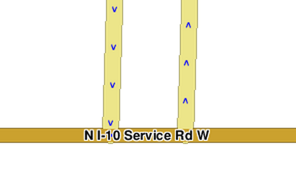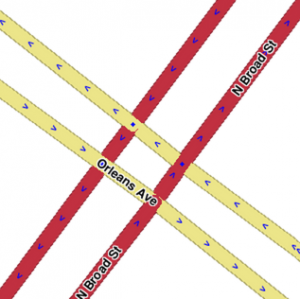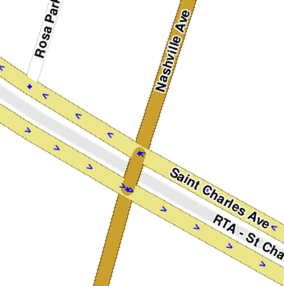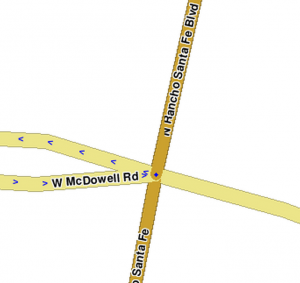Big_directions_roundabout.png (30 × 32 pixels, file size: 1 KB, MIME type: image/png)
Three-way
Right angles
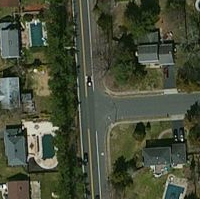
|
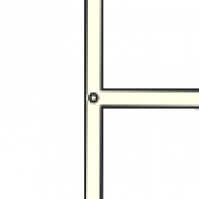
|
The simplest junctions often resemble a "T" and are considered diverging or branch roads. The branch road will normally meet the main road at nearly a 90 degree angle. This is the simplest situation to map, as the physical and logical views of the roads match up well.
Odd angles
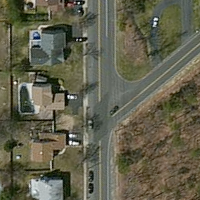
|
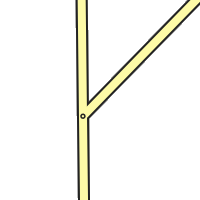
|
Some roads meet at odd angles. The initial urge will be to represent the junction as it is in the physical world - two lines running into each other at a sharp angle. But there are issues with this method.
- Depending on the angle, the client may give a "Keep Right" instruction to the driver when a "Turn Right" instruction is more appropriate. If Minor Highways or above are involved, you will actually get an "Exit Right" which can be confusing in many situations.
- In some cases, no instruction will be given at all. In the worst case, the routing server may determine that it isn't possible to make a very sharp turn angle and not suggest the turn at all (in the example image, heading south, then turning left, to head east).
- Automatic map errors may appear with turns from one direction as the path of the turning traffic is "too far" away from the actual junction (in this example, traveling south, then turning left to head east).
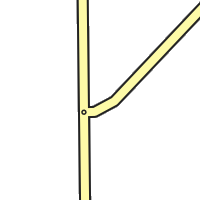
|
To eliminate ambiguity, map the junction from a logical point of view. Since basic "Turn Left" and "Turn Right" instructions are desired, tweak the intersecting angle so it resembles a basic 90 degree intersection. Add geometry nodes to make the branch road leave the main road at close to 90 degrees, then gradually curve the road to match the true departure angle. This will produce a junction that logically works like a basic 90 degree junction, but it also fits the reality of the physical world.

|
Here is a completed real world example which provides the expected turn instructions and "catches" turns from all directions avoiding automatic problems for missing road when they are "too far apart."
Name changes on straight path
For conditions where the straight through route changes road names, it is important to identify which segment is drawn as the straight route and which is shown as the right turn from the main road. As the How Waze Determines turn/keep/exit maneuvers page explains, segment names and geometry are very important in determining what navigation instructions are given.

In this example to the right, the multi-lane surface street is known as Main Street to the west and Atlantic Ave. to the east. The name change occurs when Main St. branches off as a regular surface street. That is the human description, but a more technical description would be that Main St. travels in a perfectly straight line and Atlantic Ave. branches off of it. But if we map it that way in the editor, we create a major problem.
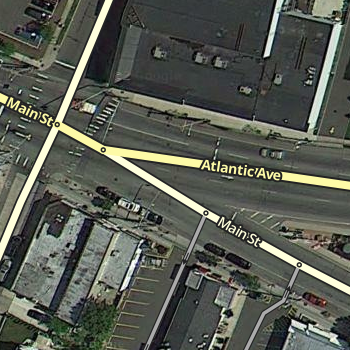
Since the multi-lane segment of Main St. and the regular street segment of Main St. have the same name, the routing engine automatically considers that to be "straight". If the two sections line up in a straight line the way they appear from the sky, then we are reinforcing the idea that "straight" is Main St. to Main St. But as a typical driver would want, "straight" should be the path that remains on the multi-lane roadway, regardless of what name it uses.
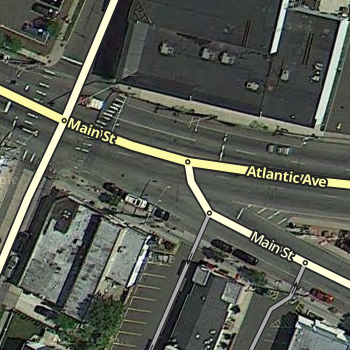
To make sure the routing engine understands the proper treatment of the junction, we have to be deliberate with the segment geometry of all three involved segments. We end up with something like the image on the right. Now the geometric definition of straight is the multi-lane portion of Main St. onto Atlantic Ave., since we have made that transition as close to zero degrees as possible. The regular street portion of Main St. now branches off at an angle close to 90 degrees. The routing engine should recognize that a turn is required. So the result is that Main St. to Atlantic Ave. has no announced turn, and multi-lane Main St. to surface road Main St. has a turn announced. Exactly what most drivers would expect in the real world.
Steep angles with exits and keep right or left
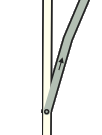
|
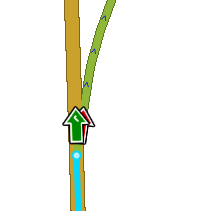
|
A ramp from a highway is another good example where additional geometry nodes are helpful. Especially since most ramps diverge at a very small angle from the road. The drawback in this case is it may be hard to see and click on the turn restriction arrows in the editor.
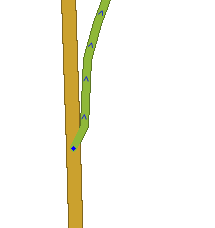
|
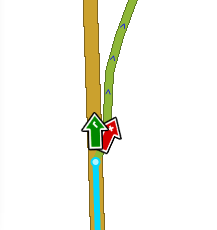
|
Therefore add one more geometry node to make the departure angle at the junction closer to 10 or 20 degrees. (dogleg) See the discussion on controlling turn instructions for details on those angles. Now the arrows are visible and accessible. Note that also pressing s in the editor will spread or separate the arrows at a junction, if a arrow is still difficult to reach. See the keyboard shortcuts article for more tips on other keys.
With this adjusted angle, this junction now behaves as expected and the turn restrictions can be easily accessed.
Four-way
Right angles
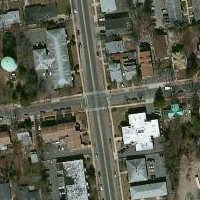
|
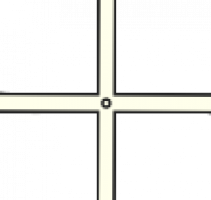
|
The second simplest junction category is a "+" or "cross" four-way junction that intersects at 90 degrees. These roads are simple to map as the logical and physical views of the roads match up well. These instructions follow the similar guidelines and solve the same problems as diverging roads.
Odd angles
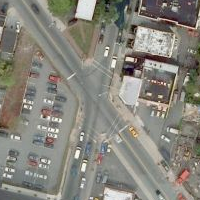
|
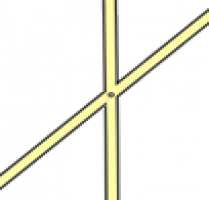
|
Similar to diverging roads that intersect at odd angles, crossing roads can do the same thing. When these intersections are mapped as seen here with these odd angles, complications can occur.
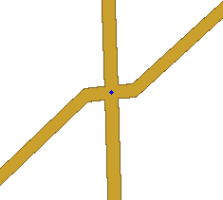
|
Geometry nodes bring the actual junction close to 90 degrees. Zoom in to the intersection and add a single geometry node on each side as close to the junction point as possible. This will give the more desirable 90 degree angle, and it will still be virtually invisible to client app users making it look like the physical world. This image is what is seen when zoomed in as close as possible. Zoomed back out, it looks just like the map image showing the junction without any geometry nodes.
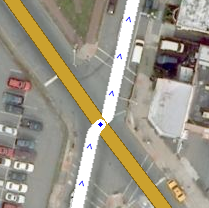
|
Here is a real world example at a close zoom level where you can still see the geometry adjustment. With that adjustment in place, the junction will produce predictable turn left and right navigation instructions while the roads still appear to meet at the real-world angle in the client app.
Split road intersections
Many of the principles stated above apply to intersections between split roads. Usually, split road intersections should represent reality.
When the name of a road is different on either side of a split road intersection, leave the median segment unnamed. This way, Waze will use the correct name when instructing the user to make a left turn.
Three way
Three way split road intersections are easier to edit accurately than four way intersections.
Four way
Four way split road intersections can often be constructed in Waze to represent reality – however, in some circumstances, alternative methods must be used.
When all split-road U turns are allowed at an intersection, or when disallowed U turns are effectively restricted in Waze by existing restricted left turns already, use the guidance in this immediate section.
When a U turn must be restricted, but both of the left turns that make up that U turn are allowed on their own, follow the guidance in Avoiding U turns below.
Avoiding U turns
At a particular split road intersection, in a case where a U turn is not allowed, but both of the left turns that make up that U turn are allowed separately, one of the following alternate intersection methods may be used.
Use these alternative methods only where necessary, and only at 4-way split road intersections (between two split roads, or between a split road and an unsplit road). Alternative methods are not necessary at 3-way split road intersections.
H junction
An H junction can be used to avoid U-turns if
- The length of the "H" cross-bar is less than Routing penalties/U-turn minimum i
- The junction angles is exactly 90 degrees.
It is useful if the center of the physical "H" is long and/or allows traffic to stop and queue within the median of the divided roadway and is long enough to justify being mapped especially if the one-way roads would have to deviate greatly from their physical location to meet in a single point for a bow tie.

Bow tie
The "bow tie" intersection method allows the restriction of U turns without restricting the left turns that make up the U turn.
Use the bow tie intersection only where necessary, and only at 4-way split road intersections (between two split roads, or between a split road and an unsplit road).
By reducing the intersection to a single point, we gain control over U-turns.
Additionally, the center segment of the H may introduce complexity to the map. If the cross street changes names at the junction, care must be taken to make the center segment have no name assigned. This will cause the segment to inherit the appropriate name depending on the direction of travel. This center segment is then different from either side so future "select all segments" operations in the editor will not capture this segment which may complicate editing.
Finally, the Waze systems also have difficulty in capturing average speeds for short segments, especially when traffic does not travel across a majority of the segment which may happen in a wide intersection. The center of the H would be totally vertical in the example above, but turning traffic would be traveling in more of a 45 degree angle. Add in the inaccuracy of many consumer GPS chips and wide intersections and you may have traffic never actually driving over the segment for certain movements.
NOTE: Be aware of the geometry used in the bow tie. If the angles are too steep (45 degrees or greater) a driver traveling along one of the one-way segments may be told to "turn" or "stay" at the intersection instead of receiving no instruction.
File history
Click on a date/time to view the file as it appeared at that time.
| Date/Time | Thumbnail | Dimensions | User | Comment | |
|---|---|---|---|---|---|
| current | 10:13, 30 November 2015 |  | 30 × 32 (1 KB) | Maintenance script (talk | contribs) | Importing file |
File usage
The following file is a duplicate of this file (more details):
- File:Big directions roundabout.png from a shared repository
There are no pages that use this file.
